කළු කුහර
මෙම ලිපිය පහසු කියැවීමට හා සැරිසැරීමට බාධා වන තරම් විශාලත්වයකින් යුක්ත වීමට ඉඩ ඇත. (2011 අගෝස්තු) |
මෙම ලිපිය වනාහි Black Hole ලිපියෙහි ඉංග්රීසි භාෂාවේ සිට සිංහල වෙත නොනිමි පරිවර්තනයකි . ඉංග්රීසි සහ සිංහල යන භාෂාවන්හි සුදුසු හා ප්රමාණවත් පරිචයක් ඇත්නම්, මෙම පරිවර්තනය සම්පූර්ණ කිරීමට ඔබට අවකාශ ඇත. අදාල විෂය පිලිබඳ දැනුවත්නම්, නැවුම් ස්වයං නිර්මාණයක් ලෙස ලිපිය සම්පූර්ණ කිරීමට ඔබට අවකාශ ඇත. |

කළු කුහරයක් (ඉංග්රීසි: Black hole) යනු කිසිදු පදාර්ථයකට මෙන්ම ආලෝකයට පවා පිටවිය නොහැකි අභ්යවකාශයේ ප්රදේශයකි. එය ඉතාමත් ඝන වූ ස්කන්ධයක් විසින් අවකාශ-කාල විරූපී කිරීමේ ප්රතිඵලයකි. කළු කුහරය වටා පවතින්නේ හඳුනා ගත නොහැකි, සිද්ධි ක්ෂිතිජය යනුවෙන් හැඳින්වෙන, නැවත නොපැමිනීමේ සීමාව ලකුණු කරන මතුපිටයි. එය කළු ලෙස හඳුන්වන්නේ එය මතට පතිත වන කිසිදු විද්යුත් චුම්භක තරංගයක් හෝ අංශුවක් පරාවර්තනය නොකර සම්පූර්ණයෙන් අවශෝෂණය කරගන්නා නිසාය. (තාප ගති විද්යාවේ එන කෘෂ්ණ වස්තු (Black Body) වැනිය).[1] ක්වොන්ටම් විද්යාවට අනුව කළු කුහර, සීමිත උෂ්ණත්වයකින් යුතු වස්තුවක් මෙන්, හෝකින් කිරණ විහිදුවයි. මෙම උෂ්ණත්වය කළු කුහරයේ ප්රමාණය අනුව අඩු වන බැවින් විශාල ස්කන්ධයකින් යුතු කළු කුහර නිරීක්ෂණය කිරීම අපහසුය.එය අදෘශ්ය වුවත්, වෙනත් පදාර්ථ සමග සිදුවන අන්තර්ක්රියා මගින් කළු කුහර හඳුනාගත හැකිය. අවකාශයේ ප්රදේශයක් වටා පරිභ්රමණය වන තරු පොකුරක චලන රටා අධ්යනය කිරීමෙන් කළු කුහරයක පිහිටීම හඳුනාගත හැකිය. එමෙන්ම, තරු යුග්මයකින් විශාල කළු කුහරයකට පදාර්ථය ඇදගන්නා විට, එම වායු සර්පිලාකිරව හැඩගැසී, අධි උෂ්ණත්වයකට භාජනය වී නිකුත් කරන විකිරණය, ප්රථිවි-ගත දුරෙක්ෂක මගින් හඳුනාගත හැක.
තාරකා විද්යාඥයින් විසින් කළු කුහර තිබිය හැකි ස්ථාන විශාල ප්රමාණයක් හඳුනාගෙන ඇති අතර, චක්රාවාට ම්ධ්යයේ supermassive කළු කුහර පැවතිය හැකි බවට සාධක සොයාගෙන ඇත. ක්ෂිර පථය මධ්යයේ Sagittarius A* ප්රදේශයේ, සූර්ය-සකන්ධ මිලියන 2කට අධික සුපිරි-විශාල කළු කුහරයක් (Supermassive Black Hole) පවතින බවට, 1998 වර්ශයේදී, විද්යාඥයින් හට ශක්තිමක් සාධක හමුවුනි. නමුත් මෑතකදි කරන ලද පරීක්ෂන වලට අනුව මෙය සූර්ය-සකන්ධ මිලියන 4කට අධික විය යුතු බව සොයාගෙන ඇත. විශ්වයේ ඇති විශාලතම කළු කුහර සූර්ය-සකන්ධ බිලියන ගණනක් විශාල වන අතර ඒවා අතිසුපිරි-විශාල කළු කුහර (Ultramassive Black Holes) ලෙස හඳුන්වයි.
ඉතිහාසය
[සංස්කරණය]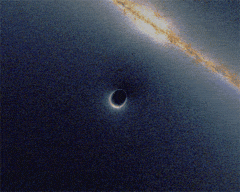
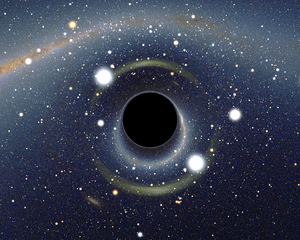
ඉතාමත් ඝන වස්තු මගින් ආලෝකයට පවා පිටවීමට නොහැකි අදහස මුලින්ම ඉදිරිපත් වූවේ භු විද්යාඥ ජෝන් මිසෂල් විසින් හෙන්රි කැවෙන්ඩිශ් හට 1783දී ලියූ ලිපියකිනි:
සූර්යයාට සමාන ඝනත්වයකින් යුත් ගෝලයක අර්ධ විෂ්කම්භය 500 ත් 1 ත් අතර අනුපාතයකින් සූර්යයාගේ විෂ්කම්භය ඉක්මවන්නේ නම්, අනන්ත උසකින් ඒ දෙසට වැටෙන අංශුවක් එහි මතුපිටට වඩා වැඩි ප්රවේගයක් ලබා ගනී. ආලෝකය, සහ එහි ප්රතිඵලයක් ලෙස ආලෝකය අනෙකුත් අංශු සමග එහි දෘෂ්ය අවස්ථිතිත්වයට සමානුපාතිකව එකම බලයකින් ආකර්ෂණය වේ යැයි උපකල්පනය කළහොත්, එවැනි අංශුවකින් විමෝචනය වන සියලුම ආලෝකය එහි නිසි ගුරුත්වාකර්ෂණයෙන් ඒ දෙසට නැවත පැමිණෙනු ඇත.
— ජෝන් මිෂෙල්[2]
1796දී ගණිතඤ පියර්-සයිමන් ලාප්ලේස්, එම අදහසම, ඔහුගේ Exposition du système du Monde ග්රන්ථයේ පළමුවන සහ දෙවන සංස්කරණ වලින් ඉදිරිපත් කර තිබුනි (පසු සංස්කරණ වලින් එය ඉවත් කෙරිණි). [3][4] එවන් අඳුරු තාරකා පිළිබඳ අදහස 19 ශතකයේ විශාල වශයෙන් ප්රතික්ෂේප විණි. එම කාලයේ ගුරුත්වාකර්ශෂණය මගින් ආලෝකයට බලපෑම් කල නොහැකි බවට විශ්වාස කෙරිණි.
සාමාන්ය සාපේක්ෂතාවාදය
[සංස්කරණය]1915 දී ඇල්බට් අයින්ස්ටයින් විසින් සාමාන්ය සාපේක්ෂතාවාදය ඉදිරිපත් කලේ ගුරුත්වාකර්ෂණය ආලෝකයේ ගමන් මාර්ගයට බලපෑම් කරන බව පෙන්වා දීමෙන් පසුවය. ඉන් මාස කිහිපයකට පසුව Karl Schwarzschild විසින් ලක්ෂ්ය-ස්කන්ධයක සහ ගොලීය ස්කන්ධයක ගුරුත්වාකර්ෂණයට විසඳුමක් ලබා දුන්නේය.[5] තවත් මාස කිහිපයකට පසු Schwarzschild සහ Hendrik Lorentz ගේ ශිෂ්යයෙකු වූ Johannes Droste, තනි තනිවම ඒවාගේ ලක්ෂණ පිළිබඳව වැඩිදුර ලිව්වෝය.[6] මෙම විසඳුම වර්තමානයේ ෂ්වාස්චයිල්ඩ් අරය ලෙස හැඳින්වෙන සුවිශේෂී හැසිරීමක් ඇති අතර එය ඒකීය බවට පත් විය, එයින් අදහස් වන්නේ අයින්ස්ටයින් සමීකරණවල සමහර යෙදුම් අනන්තය බවට පත්ව ඇති බවයි. මෙම පෘෂ් of යේ ස්වභාවය එකල එතරම් අවබෝධ වී නොතිබුණි. 1924 දී ආතර් එඩින්ග්ටන් පෙන්නුම් කළේ ඛණ්ඩාංක වෙනස් වීමෙන් පසුව ඒකීයභාවය අතුරුදහන් වූ බවයි (එඩින්ටන් ඛණ්ඩාංක බලන්න), නමුත් 1933 වන තෙක් ජෝර්ජස් ලෙමාට්රේට මෙය තේරුණේ ෂ්වාස්චයිල්ඩ් අරයෙහි ඒකීය භාවය භෞතික නොවන ඛණ්ඩාංක ඒකීය භාවයක් බව වටහා ගැනීමටය..[7]
891/5000
1931 දී සුබ්රමනියම් චන්ද්රසේකර විසින් සාමාන්ය සාපේක්ෂතාවාදයෙන් ගණනය කරන ලද අතර ඉලෙක්ට්රෝන පරිහානිගත ද්රව්ය 1.04 ස්කන්ධ ස්කන්ධයන් (චන්ද්රසේකර සීමාව) බිඳවැටෙනු ඇත. ඔහුගේ තර්කවලට එඩින්ටන් සහ ලෙව් ලන්ඩෝ වැනි බොහෝ සමකාලීනයන් විසින් විරුද්ධ වූ අතර, තවමත් නොදන්නා යාන්ත්රණයක් බිඳවැටීම නතර කරන බවට තර්ක කළහ. ඒවා අර්ධ වශයෙන් නිවැරදියි: චන්ද්රසේකර් සීමාවට වඩා කුඩා විශාල වාමනාවක් නියුට්රෝන තාරකාවක බිඳ වැටෙනු ඇත, පාවුලි බැහැර කිරීමේ මූලධර්මය නිසා ස්ථායී වේ. එහෙත් 1939 දී රොබට් ඔප්න්හෙමාර් සහ අනෙකුත් අය අනාවැකි පළ කළේ සූර්ය ස්කන්ධ 3 ක් පමණ වන නියුට්රෝන තාරකා (ටෝල්මෑන්-ඔප්න්හයිමර්-වොල්කොෆ් සීමාව) කළු කුහර බවට කඩා වැටෙනු ඇති අතර, භෞතික විද්යාවේ කිසිදු නීතියක් මැදිහත් වීමට ඉඩ නොතබන බව නිගමනය කලේය. අඩුම තරමින් සමහර තරු කළු කුහර දක්වා කඩා වැටෙනු ඇත
[8].ඒවා අර්ධ වශයෙන් නිවැරදි ය: චන්ද්රසේකර් සීමාවට වඩා තරමක් විශාල සුදු වාමන නියුට්රෝන තාරකාවකට කඩා වැටෙනු ඇත. එය පෝලි බැහැර කිරීමේ මූලධර්මය නිසා ස්ථායී වේ. නමුත් 1939 දී රොබට් ඔපන්හෙයිමර් සහ තවත් අය අනාවැකි පළ කළේ ආසන්න වශයෙන් සූර්ය ස්කන්ධ තුනකට වඩා වැඩි නියුට්රෝන තාරකා (ටෝල්මන්-ඔපන්හෙයිමර්-වොල්කොෆ් සීමාව) චන්ද්රසේකර් විසින් ඉදිරිපත් කරන ලද හේතු නිසා කළු කුහර වලට කඩා වැටෙනු ඇති අතර භෞතික විද්යාවේ කිසිදු නීතියක් මැදිහත් නොවන බවත් නිගමනය කළ බවත්ය. අවම වශයෙන් සමහර තරු කළු කුහර වලට කඩා වැටීම නවත්වන්න[9]
ඔපන්හෙයිමර් සහ ඔහුගේ සම කර්තෘවරු ෂ්වාස්චයිල්ඩ් අරයෙහි මායිමේ ඇති ඒකීයභාවය අර්ථකථනය කළේ මෙය කාලය නතර වූ බුබුලක මායිම බවයි. මෙය බාහිර නිරීක්ෂකයින් සඳහා වලංගු දෘෂ්ටි කෝණයකි, නමුත් වැරදි නිරීක්ෂකයින් සඳහා නොවේ. මෙම දේපල නිසා, කඩා වැටුණු තාරකාවන් "ශීත කළ තරු" ලෙස හැඳින්වේ.[10] මක්නිසාද යත් බාහිර නිරීක්ෂකයෙකුට තාරකාවේ පෘෂ් surface ය කාලයාගේ ඇවෑමෙන් ශීත කළ බව පෙනෙනු ඇත. මෙය නූතන කළු කුහරවල දන්නා දේපලකි, නමුත් ශීත කළ තාරකාවේ මතුපිටින් ලැබෙන ආලෝකය ඉතා වේගයෙන් රතු පැහැයට හැරෙන අතර කළු කුහරය ඉතා ඉක්මණින් කළු පැහැයට හැරේ. බොහෝ භෞතික විද්යා ists යන්ට ෂ්වාස්චයිල්ඩ් අරය තුළ රැඳී සිටීම පිළිබඳ අදහස පිළිගැනීමට නොහැකි වූ අතර වසර 20 කට වැඩි කාලයක් තිස්සේ මෙම විෂය කෙරෙහි එතරම් උනන්දුවක් නොතිබුණි.
ස්වර්ණමය යුගය
[සංස්කරණය]1958 දී , ඩේවිඩ් ෆින්ස්කෙලේෂ්ටින් අවබෝද කරගන්නා ලද මෙය ඔපන්හයිමර්ගේ ප්රතිඵලවලට තදින්ම පටහැනි නොවූ නමුත්, නිරීක්ෂකයන්ගේ බලපෑමට ලක්වීමේ දෘෂ්ටිකෝණය ඇතුළත් කිරීමට ඒවා දීර්ඝ කළේය.ෆින්ස්කෙලේෂ්ටින් ගේ විසඳුම කළු කුහරයට වැටෙන නිරීක්ෂකයින්ගේ අනාගතය සඳහා Schwarzschild විසඳුම දිගු කළේය. සම්පූර්ණ දිගුවක් දැනටමත් මාටින් කෘස්කාල් විසින් සොයාගෙන ඇති අතර, එය ප්රකාශයට පත් කරන ලෙස ඉල්ලා සිටියේය.
මෙම ප්රතිඵල පැමිණියේ සාමාන්ය සාපේක්ෂතාවාදයේ ස්වර්ණමය යුගයේ ආරම්භයේදී වන අතර එය සාමාන්ය සාපේක්ෂතාවාදය සහ කළු කුහර පර්යේෂණයේ ප්රධාන විෂය ධාරාවන් බවට පත්වීම මගින් සලකුණු කර ඇත. වේගයෙන් භ්රමණය වන නියුට්රෝන තරු ලෙස පෙන්වූ වසර කිහිපයක් ඇතුළත 1967 දී පල්සර් සොයා ගැනීම මෙම ක්රියාවලියට උපකාරී විය. ඒ වන තරු, කළු කුහර වැනි නියුට්රෝන තාරකා, හුදෙක් න්යායික කුතුහලයන් පමනක් ලෙස සලකනු ලැබීය. නමුත් පල්සර් සොයා ගැනීම ඔවුන්ගේ භෞතික අදාළත්වය පෙන්නුම් කළ අතර ගුරුත්වාකර්ෂණ බිඳවැටීමෙන් සෑදිය හැකි සියලු වර්ගවල සංයුක්ත වස්තූන් කෙරෙහි තවදුරටත් උනන්දුවක් ඇති කළේය.
මෙම කාල පරිච්චේදය තුළ වඩාත් පොදු කළු කුහර විසඳුම් සොයා ගන්නා ලදී. 1963 දී Roy Kerr විසින් භ්රමණය වන කළු කුහරයක් සඳහා නිවැරදි විසඳුම සොයා ගන්නා ලදී. වසර දෙකකට පසුව Ezra T. Newman විසින් භ්රමණය වන සහ විද්යුත් ආරෝපණය වන කළු කුහරයක් සඳහා අක්ෂ සමමිතික විසඳුම සොයා ගන්නා ලදී,
[11]කළු කුහර ද්රාවණවල ඇති අමුතු ලක්ෂණ පනවා ඇති සමමිතික තත්ත්වයෙන් ව්යාධිජනක කෞතුක ද්රව්ය බවටත්, සාමාන්ය අවස්ථාවන්හිදී ඒකවචනයන් නොපෙන්වන බවටත් දීර්ඝ කාලයක් තිස්සේ සැක පහළ විය. මෙම මතය විශේෂයෙන්ම බෙලින්ස්කි, ඛලට්නිකොව් සහ ලිෆ්ෂිට්ස් විසින් පැවැත්විණි, ඔවුන් සාමාන්ය විසඳුම්වල ඒකීය බවක් නොපෙන්වන බව ඔප්පු කිරීමට උත්සාහ කළහ. කෙසේ වෙතත්, හැටේ දශකයේ අගභාගයේදී රොජර් පෙන්රෝස් සහ ස්ටීවන් හෝකින් විසින් ඒකීයත්වය සාමාන්ය බව ඔප්පු කිරීමට ගෝලීය ශිල්පීය ක්රම භාවිතා කළහ.
"කළු කුහරය" යන යෙදුම ප්රථම වරට ප්රසිද්ධියේ භාවිතා කරන ලද්දේ 1967 දී දේශනයකදී ජෝන් වීලර් විසිනි. සාමාන්යයෙන් මෙම වාක්ය ඛණ්ඩය නිර්මාණය කිරීමේ ගෞරවය ඔහුට හිමි වුවද, එය ඔහුට වෙනත් අයෙකු විසින් යෝජනා කළ බව ඔහු නිතරම අවධාරනය කළේය. මෙම යෙදුමේ පළමු වාර්තාගත භාවිතය 1964 දී ඈන් එවින්ග් විසින් විද්යාවේ දියුණුව සඳහා වූ ඇමරිකානු සංගමයට ලියූ ලිපියකි. වීලර් විසින් මෙම පදය භාවිතා කිරීමෙන් පසුව, එය ඉක්මනින් සාමාන්ය භාවිතයේ දී සම්මත විය.
ලක්ෂණ සහ ව්යුහ
[සංස්කරණය]මෙම කොටස හිස්ය. එය පුළුල් කිරීමෙන් ඔබ හට උපකාර කළ හැක. |
භෞතික ලක්ෂණ
[සංස්කරණය]| Class | Mass | Size |
|---|---|---|
| Supermassive black hole | ~105–109 MSun | ~0.001–10 AU |
| Intermediate-mass black hole | ~103 MSun | ~103 km = REarth |
| Stellar black hole | ~10 MSun | ~30 km |
| Micro black hole | up to ~MMoon | up to ~0.1 mm |
මෙම කොටස හිස්ය. එය පුළුල් කිරීමෙන් ඔබ හට උපකාර කළ හැක. |
සිද්ධි ක්ෂිතිජය
[සංස්කරණය]
මෙම කොටස හිස්ය. එය පුළුල් කිරීමෙන් ඔබ හට උපකාර කළ හැක. |
ලක්ෂ්ය-භාවය
[සංස්කරණය]සිද්ධි ක්ෂිතිජය යනු කලු කුහරයේ මධ්ය ලක්ෂය වේ.සාමාන්ය සාපේක්ෂතාවාදය මගින් විස්තර කර ඇති පරිදි එය කාලඅවකාශය අනන්තයටම වන කලාපයක් විය හැක. භ්රමණය නොවන කළු කුහරයක් සඳහා, මෙම කලාපය තනි ලක්ෂ්යයක හැඩය ගනී.එම ඒකීය කලාපයට අනන්ත ඝනත්වයක් ඇති බව සිතිය හැක. යම් කිසි මිනිසෙක් කලු කුහරය තුලට ඇදවැටුනහොත් ඔහු කෙටි දුරක් යන විටම අනන්ත ස්කන්ධය විසින් ඇද ඉරී යනු ඇත(මෙහිදී දෙපයට සාපේක්ශව සාපේක්ශව හිසට ක්රියාත්මක වන ගුරුත්වය අඩුය.එබැවින් දෙපයින් වැඩි බලයකින්ද හිසින් ඊට සාපේක්ශව අඩු බලයකින් අදිනු ලබයි. එවිට එම පුද්ගලයාව පරමාණු දක්වාම ඇදී ඉරී යයි.මෙය "noodle effect" ලෙස හදුන්වනු ලබයි.) එම ඇදගන්නා දෙය අනන්ත ස්කන්ධය මගින් ඇද තලා දාමා ඉන්පසු එය ගිලගනී. මෙසේ වස්තූන් ගිලගන්නා විට කලු කුහරයේ ස්කන්ධය තවදුරටත් වැඩි වෙයි. සිද්ධි ක්ෂිතිජයේදි විශ්වයේ අනිකුත් තැන් වල ක්රියාත්මක වන අප දන්නා භෞතික විද්යා නියම සියල්ල බිදවැටෙයි.(article by: Dulen S.L)
ෆෝටෝන ගෝලය
[සංස්කරණය]මෙම කොටස හිස්ය. එය පුළුල් කිරීමෙන් ඔබ හට උපකාර කළ හැක. |
Ergo ගෝලය
[සංස්කරණය]
මෙම කොටස හිස්ය. එය පුළුල් කිරීමෙන් ඔබ හට උපකාර කළ හැක. |
බිහිවීම සහ සකස් වීම
[සංස්කරණය]මෙම කොටස හිස්ය. එය පුළුල් කිරීමෙන් ඔබ හට උපකාර කළ හැක. |
ගුරුත්වාක්ෂණ හැකිළීම
[සංස්කරණය]ගුරුත්වාකර්ෂණ හැකිලීම සිදුවන්නේ යම් වස්තුවක අංශු අතර ඇතිවන ගුරුත්වාකර්ණයට ඔරොත්තු දීමට තරම් එහි අභ්යන්තර පීඩනය ප්රමාණවත් නොවීමය. තාරකාවකට මෙය සිදුවන්නේ න්යෂ්ටික-විලයනය මගින් එහි උෂ්ණත්වය පවත්වා ගැනීමට තරම් එහි ඉන්ධන ප්රමාණවත් නොවීම හෝ පිටතින් අමතර පදාර්ථයක් එක්වී එහි ස්කන්ධය වැඩි වීම නිසාය. මෙවන් අවස්ථාවකදී තාරකාවේ ගුරුත්වය මගින් තමාවම හකුලවාගැනීම වැලැක්වීමට එහි උෂ්ණත්වය අසමත් වෙයි.[12]
මහා පිපිරුමේ ප්රථමාරම්භ කළු කුහර
[සංස්කරණය]මෙම කොටස හිස්ය. එය පුළුල් කිරීමෙන් ඔබ හට උපකාර කළ හැක. |
අධි ශක්ති ඝට්ටනය
[සංස්කරණය]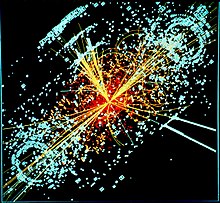
මෙම කොටස හිස්ය. එය පුළුල් කිරීමෙන් ඔබ හට උපකාර කළ හැක. |
වර්ධනය
[සංස්කරණය]කළු කුහරයක් ඇතිවීමෙන් පසු එය පිටතින් පදාරථ උරා ගනිමින් වර්ධනය වීමට පටන් ගනී. ඕනෑම කළු කුහරයක් දිගින් දිගටම අවට ඇති වාතය සහ අභ්යවකාශ දූවිලි මෙන්ම සර්වව්යාප්ත විශ්ව පසුබිම් විකිරණයද උරා ගනී. අධි-ස්කන්ධ කළු කුහර වරධනය වීමට ප්රාථමික දායක්ත්වය ලැබී ඇත්තේ මෙම කියාවලිය මගිනි.[13] ගෝලාකාර තරු පොකුරු වල මධ්යම ප්රමාණයේ කළු කුහර සෑදී ඇත්තේද මෙමගින් බවට යෝජනා වී ඇත.[14]
කළු කුහරයකට තාරකාවක් මෙන්ම තවත් කළු කුහරයක් සමග බද්ධ විමේ හැකියාවක් ඇත. කුඩා වස්තු කීපයක එකතුවකින් සෑදී ඇති අධි-ස්කන්ධ කළු කුහරවල ප්රථම අවදියේදී ඒවා වර්ධනය වීමට මෙවැනි දෑ වැගදත් වී ඇති බවට විශ්වාස කෙරෙයි.[13] සමහරක් මධ්යම ප්රමාණයේ කළු කුහර ආරම්භය වීම සඳහා දායක වූ බවටද මෙම ක්රියාවලිය යෝජනා වී ඇත.[15][16]
වාෂ්පවීම
[සංස්කරණය]මෙම කොටස හිස්ය. එය පුළුල් කිරීමෙන් ඔබ හට උපකාර කළ හැක. |
නිරීක්ෂණය කල සාක්ෂි
[සංස්කරණය]මෙම කොටස හිස්ය. එය පුළුල් කිරීමෙන් ඔබ හට උපකාර කළ හැක. |
පදාර්ථ එකතුවීම
[සංස්කරණය]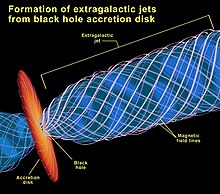
මෙම කොටස හිස්ය. එය පුළුල් කිරීමෙන් ඔබ හට උපකාර කළ හැක. |
X-කිරණ තරු යුග්ම
[සංස්කරණය]
මෙම කොටස හිස්ය. එය පුළුල් කිරීමෙන් ඔබ හට උපකාර කළ හැක. |
Quiescence and advection-dominated accretion flow
[සංස්කරණය]මෙම කොටස හිස්ය. එය පුළුල් කිරීමෙන් ඔබ හට උපකාර කළ හැක. |
Quasi-periodic oscillations
[සංස්කරණය]මෙම කොටස හිස්ය. එය පුළුල් කිරීමෙන් ඔබ හට උපකාර කළ හැක. |
ගැමා කිරණ පිපිරුම්
[සංස්කරණය]මෙම කොටස හිස්ය. එය පුළුල් කිරීමෙන් ඔබ හට උපකාර කළ හැක. |
නියුට්රෝන තරු දෙකක් එකිනෙක ඝට්ටනය වීමේදී පිටවන අධිශක්ති විකිරණ ගැමා කිරණ පිපිරුමක් ලෙස හැඳින්විය හැකිය බොහෝ විට නියුට්රෝන තරු දෙකක් එකිනෙක හා වේගයෙන් ගැටීමේදී දෙපසට විහිදී යන අති විශාල ශක්ති ප්රමාණයකි එහි අඩංගු අධික ගැමා කිරණ ප්රමාණ නිසා එය ගැමා කිරලා පිපුරුමක් ලෙස හඳුන්වයි
චක්රාවාට කේන්ද්ර
[සංස්කරණය]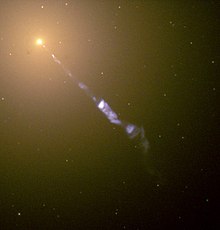
මෙම කොටස හිස්ය. එය පුළුල් කිරීමෙන් ඔබ හට උපකාර කළ හැක. |
චක්රාවාට කේන්ද්රය එනම් චක්රාවාටය මැද බොහෝ විට කළු කුහරයක් පවතී. ක්ෂීරපථ මන්දාකිණිය වන අපගේ මන්දාකිණිය මධ්යයේ අති විශාල කළු කුහරයක් (supermassive black hole) පවතී. එහි පවත්නා අධික ගුරුත්වාකර්ෂණ බලය නිසා චක්රාවාට සම්පූර්ණ ස්කන්ධයන් ඒ වෙත ආකර්ෂණය වී ඇත. කෙටියෙන් කිවහොත් සූර්යයා ඇතුළු අපගේ සෞරග්රහ මණ්ඩලය ද ක්ෂීරපථ මන්දාකිණියේ වූ දහස් ගණනක් තාරකා ද එම කළු කුහරය වෙත ආකර්ෂණය වී පවතී.
ගුරුත්ව කාච
[සංස්කරණය]ගුරුත්වාකර්ෂණ කාචයක් නිරීක්ෂකයෙකු වෙත ගමන් කරන විට ආලෝකයේ ආලෝකය විහිදුවන හැකියාවෙන් දුරස්ථ ආලෝක ප්රභවයක් සහ නිරීක්ෂකයකු අතර යම් ද්රව්යයක් බෙදා හැරීම (පදාර්ථ පොකුරු වැනි) බෙදා හැරීමකි. මෙම බලපෑම ගුරුත්වාකර්ෂණ ආතතිය ලෙස හැඳින්වේ. ඇල්බට් අයින්ස්ටයින්ගේ සාපේක්ෂතාවාදය පිළිබඳ සාමාන්ය න්යායේ පුරෝකථනයන්ගෙන් එකක් වන්නේ නැමීමේ ප්රමාණයයි.(සම්භාව්ය භෞතික විද්යාව ආලෝකයේ නැඹුරුවක් ද අනාවැකි පල කරයි, නමුත් සාමාන්ය සාපේක්ෂතාවාදයෙන් පුරෝකථනය කරන ලද භාගය පමණයි.
විකල්ප
[සංස්කරණය]මෙම කොටස හිස්ය. එය පුළුල් කිරීමෙන් ඔබ හට උපකාර කළ හැක. |
විවෘත විමසීම්
[සංස්කරණය]එන්ට්රෝපිය සහ thermodynamics
[සංස්කරණය]මෙම කොටස හිස්ය. එය පුළුල් කිරීමෙන් ඔබ හට උපකාර කළ හැක. |
කළු කුහර ඒකීය භාවය
[සංස්කරණය]sf
| කළු කුහරයක් තුලදී භෞතික තොරතුරු (physical information) නැතිවෙනවාද? |
මෙම කොටස හිස්ය. එය පුළුල් කිරීමෙන් ඔබ හට උපකාර කළ හැක. |
අමතර අවධානයට
[සංස්කරණය]- Binary black hole
- Black brane or Black string
- Black Hole Initiative
- Black hole starship
- Black holes in fiction
- Blanet
- BTZ black hole
- Charged black hole
- Direct collapse black hole
- Golden binary
- Hypothetical black hole (disambiguation)
- Kugelblitz (astrophysics)
- List of black holes
- List of nearest black holes
- Outline of black holes
- Sonic black hole
- Virtual black hole
- Susskind-Hawking battle
- Timeline of black hole physics
- White hole
- Planck star
- Dark star (dark matter)
- Schwarzschild radius
සටහන්
[සංස්කරණය]මූලාශ්ර
[සංස්කරණය]- ^ {{=http://cosmos.asu.edu/publications/papers/ThermodynamicTheoryofBlackHoles%2034.pdf සංරක්ෂණය කළ පිටපත 2008-07-19 at the Wayback Machine | journal = Rep. Prog. Phys. | author = Davies, P. C. W. | volume = 41 | year = 1978 | pages = 1313–1355 | doi = 10.1088/0034-4885/41/8/004 | ref = harv}}
- ^ Michell, J. (1784). "On the Means of Discovering the Distance, Magnitude, &c. of the Fixed Stars, in Consequence of the Diminution of the Velocity of Their Light, in Case Such a Diminution Should be Found to Take Place in any of Them, and Such Other Data Should be Procured from Observations, as Would be Farther Necessary for That Purpose". Phil. Trans. R. Soc. (London). 74. Philosophical Transactions of the Royal Society of London, Vol. 74: 35–57.
{{cite journal}}: Invalid|ref=harv(help) - ^ "Dark Stars (1783)". Thinkquest. 1999. සම්ප්රවේශය 2008-05-28.
- ^ Laplace; see Israel, Werner (1987), "Dark stars: the evolution of an idea", in Hawking, Stephen W. & Israel, Werner, 300 Years of Gravitation, Cambridge University Press, Sec. 7.4
- ^ Schwarzschild, K. (1916). "Über das Gravitationsfeld eines Massenpunktes nach der Einsteinschen Theorie". Sitzungsberichte der Königlich Preussischen Akademie der Wissenschaften. 7: 189–196. Bibcode:1916SPAW.......189S.
- Translation: Antoci, S.; Loinger, A. (1999). "On the gravitational field of a mass point according to Einstein's theory". . and Schwarzschild, K. (1916). "Über das Gravitationsfeld einer Kugel aus inkompressibler Flüssigkeit nach der Einsteinschen Theorie". Sitzungsberichte der Königlich Preussischen Akademie der Wissenschaften. 18: 424–434. Bibcode:1916skpa.conf..424S.
- Translation: Antoci, S. (1999). "On the gravitational field of a sphere of incompressible fluid according to Einstein's theory". .
- ^ Droste, J. (1915). "On the field of a single centre in Einstein's theory of gravitation". Koninklijke Nederlandsche Akademie van Wetenschappen Proceedings. 17 (3): 998–1011.
{{cite journal}}: Invalid|ref=harv(help) - ^ 't Hooft, G. (2009). Introduction to the Theory of Black Holes (PDF). pp. 47–48.
- ^ Detweiler, S. (1981). "Resource letter BH-1: Black holes". American Journal of Physics. 49 (5, pp): 394–400. doi:10.1119/1.12686. ISSN 0002-9505.
{{cite journal}}: Invalid|ref=harv(help) - ^ Oppenheimer, J. R. and Volkoff, G. M. (1939-01-03). "On Massive Neutron Cores". Physical Review. 55 (4): 374–381. doi:10.1103/PhysRev.55.374. 2011-11-20 දින මුල් පිටපත වෙතින් සංරක්ෂණය කරන ලදී. සම්ප්රවේශය 2010-10-17.
{{cite journal}}: Invalid|ref=harv(help)CS1 maint: multiple names: authors list (link) - ^ Ruffini, Remo and Wheeler, John A. (January 1971). "Introducing the black hole" (PDF). Physics Today: 30–41.
{{cite journal}}: Invalid|ref=harv(help)CS1 maint: multiple names: authors list (link) - ^ Hawking, S. W. (1974). "Black hole explosions?". Nature. 248 (5443): 30–31. Bibcode:1974Natur.248...30H. doi:10.1038/248030a0. S2CID 4290107.
- ^ Carroll 2004, Section 5.8
- ^ a b Rees, M. J.; Volonteri, M. (2007). Karas, V.; Matt, G. (eds.). Massive black holes: Formation and evolution. Proceedings of the International Astronomical Union. Vol. 238. pp. 51–58. arXiv:astro-ph/0701512. Bibcode:2007IAUS..238...51R. doi:10.1017/S1743921307004681. ISBN 978-0-521-86347-6. S2CID 14844338.
{{cite book}}:|journal=ignored (help) - ^ Vesperini, E.; McMillan, S.L.W.; D'Ercole, A.; D'Antona, F. (2010). "Intermediate-Mass Black Holes in Early Globular Clusters". [astro-ph.GA].
- ^
This citation will be automatically completed in the next few minutes. You can jump the queue or expand by hand - ^
This citation will be automatically completed in the next few minutes. You can jump the queue or expand by hand
ආශ්රිත ග්රන්ථ
[සංස්කරණය]- Popular reading
- Ferguson, Kitty (1991). Black Holes in Space-Time. Watts Franklin. ISBN 0-531-12524-6..
- Hawking, Stephen (1988). A Brief History of Time. Bantam Books, Inc. ISBN 0-553-38016-8..
- Hawking, Stephen; Penrose, Roger (1996). The Nature of Space and Time. Princeton University Press. ISBN 0-691-03791-2.
{{cite book}}: Check|isbn=value: checksum (help). - Melia, Fulvio (2003). The Black Hole at the Center of Our Galaxy. Princeton U Press. ISBN 978-0-691-09505-9..
- Melia, Fulvio (2003). The Edge of Infinity. Supermassive Black Holes in the Universe. Cambridge U Press. ISBN 978-0-521-81405-8..
- Pickover, Clifford (1998). Black Holes: A Traveler's Guide. Wiley, John & Sons, Inc. ISBN 0-471-19704-1..
- Stern, B. (2008). "Blackhole"., poem.
- Thorne, Kip S. (1994). Black Holes and Time Warps. Norton, W. W. & Company, Inc. ISBN 0-393-31276-3..
- Wheeler, J. Craig (2007). Cosmic Catastrophes (2nd ed.). Cambridge University Press. ISBN 0-521-85714-7.
{{cite book}}: Invalid|ref=harv(help)
- University textbooks and monographs
- Carroll, Sean M. (2004). Spacetime and Geometry. Addison Wesley. ISBN 0-8053-8732-3.
{{cite book}}: Invalid|ref=harv(help), the lecture notes on which the book was based are available for free from Sean Carroll's website සංරක්ෂණය කළ පිටපත 2007-06-13 at the Wayback Machine. - Carter, B. (1973). "Black hole equilibrium states". In DeWitt, B.S.; DeWitt, C. (eds.). Black Holes..
- Chandrasekhar, Subrahmanyan (1999). Mathematical Theory of Black Holes. Oxford University Press. ISBN 0-19-850370-9..
- Frolov, V.P.; Novikov, I.D. (1998). "Black hole physics".
{{cite journal}}: Cite journal requires|journal=(help); Invalid|ref=harv(help). - Hawking, S.W.; Ellis, G.F.R. (1973). Large Scale Structure of space time. Cambridge University Press. ISBN 0521099064.
{{cite book}}: More than one of|author=and|last1=specified (help). - Melia, Fulvio (2007). The Galactic Supermassive Black Hole. Princeton U Press. ISBN 978-0-691-13129-0..
- Taylor, Edwin F.; Wheeler, John Archibald (2000). Exploring Black Holes. Addison Wesley Longman. ISBN 0-201-38423-X..
- Thorne, Kip S.; Misner, Charles; Wheeler, John (1973). Gravitation. W. H. Freeman and Company. ISBN 0-7167-0344-0..
- Wald, Robert M. (1992). Space, Time, and Gravity: The Theory of the Big Bang and Black Holes. University of Chicago Press. ISBN 0-226-87029-4..
- Review papers
- Detweiler, S. (1981). "Resource letter BH-1: Black holes". American Journal of Physics. 49 (5, pp): 394–400. doi:10.1119/1.12686. ISSN 0002-9505.
{{cite journal}}: Invalid|ref=harv(help)
This citation will be automatically completed in the next few minutes. You can jump the queue or expand by hand- Hughes, Scott A. (2005). "Trust but verify: The case for astrophysical black holes". [hep-ph]. Lecture notes from 2005 SLAC Summer Institute.
භාහිර සබැඳි
[සංස්කරණය]- Stanford Encyclopedia of Philosophy: "Singularities and Black Holes" by Erik Curiel and Peter Bokulich.
- "Black hole" on Scholarpedia.
- Black Holes: Gravity's Relentless Pull - Interactive multimedia Web site about the physics and astronomy of black holes from the Space Telescope Science Institute
- FAQ on black holes
- "Schwarzschild Geometry සංරක්ෂණය කළ පිටපත 1998-01-18 at the Wayback Machine" on Andrew Hamilton’s website සංරක්ෂණය කළ පිටපත 2011-06-06 at the Wayback Machine
- UT Brownsville Group Simulates Spinning Black-Hole Binaries සංරක්ෂණය කළ පිටපත 2015-09-12 at the Wayback Machine
- Advanced Mathematics of Black Hole Evaporation
- Videos
- 16-year long study tracks stars orbiting Milky Way black hole
- Yale University Video Lecture: Introduction to Black Holes සංරක්ෂණය කළ පිටපත 2008-01-15 at the Wayback Machine at Google Video.
- Movie of Black Hole Candidate from Max Planck Institute සංරක්ෂණය කළ පිටපත 2006-09-04 at the Wayback Machine
- News
- "Black Hole confirmed in Milky Way." Retrieved December 10, 2008
- Black Hole Research News





